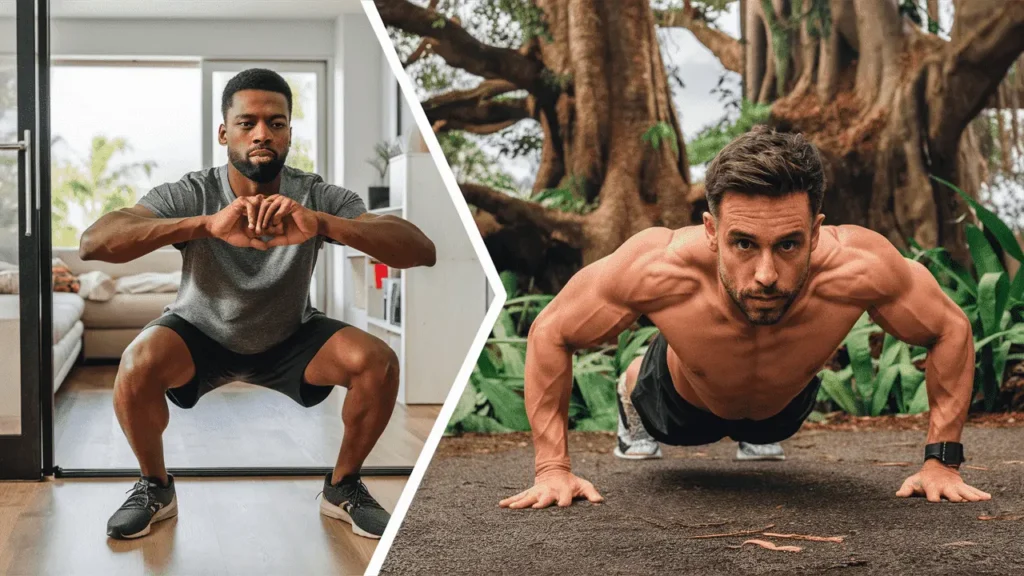Smash fitness myths & build a workout routine you love! This beginner’s guide debunks misconceptions, offers expert tips on diet & exercise, and provides FAQs to keep you on track. Start your fitness journey informed and empowered!
Contents
- 1 Introduction
- 2 The Maze of Misconceptions: Common Fitness Myths Debunked
- 2.1 Myth 1: No Pain, No Gain – Embracing Progress Over Punishment
- 2.2 Myth 2: Belly Busting Lies: Why Crunches Won’t Sculpt Your Six-Pack
- 2.3 Myth 3: Building Strength, Not Bulk: Why Ladies Should Lift Weights
- 2.4 Myth 4: Cardio Queen? Debunking the Myth of Weight Loss Royalty
- 2.5 Myth 5: Forget the Fancy Gyms: Unleash Your Inner Athlete at Home (or Anywhere!)
- 3 Truth Be Told: Essential Fitness Truths for Beginners
- 4 Conclusion
- 5 FAQ
Introduction
Stepping into the exciting world of fitness can feel like navigating a labyrinth. You’re bombarded with information, from the latest workout trends to conflicting advice from well-meaning friends. But amidst the noise, there lurk deceptive fitness myths that can derail your progress and leave you feeling discouraged. Fear not, intrepid fitness rookie! This guide will equip you with the knowledge to smash those myths and embark on a successful fitness journey.
The Maze of Misconceptions: Common Fitness Myths Debunked
Myth 1: No Pain, No Gain – Embracing Progress Over Punishment

Imagine this: you lace up your sneakers, brimming with enthusiasm for your first workout. You push yourself to the limit, fueled by the mantra “no pain, no gain.” While there’s a certain satisfaction in pushing your limits, this myth can be dangerous for beginners. Overtraining can lead to injuries like muscle strains and joint pain, leaving you sidelined and frustrated.
The key is to prioritize proper form over intensity. Focus on mastering the fundamentals of each exercise before gradually increasing the weight or difficulty. Listen to your body – there’s a difference between the satisfying burn of a challenged muscle and the sharp pain that signals potential injury. Embrace progress, not punishment!
Myth 2: Belly Busting Lies: Why Crunches Won’t Sculpt Your Six-Pack

Many beginners chase the elusive dream of spot reduction – targeting stubborn fat deposits with specific exercises. Unfortunately, science doesn’t support this myth. Fat loss is a holistic process influenced by factors like genetics and body composition. Acing hundreds of crunches might strengthen your core, but they won’t magically melt away belly fat.
The key to achieving a toned look lies in a two-pronged approach: building muscle mass through strength training and reducing overall body fat through a balanced diet and exercise routine. Strength training increases your metabolic rate, meaning your body burns more calories even at rest. So, ditch the endless crunches and embrace a well-rounded fitness plan.
Myth 3: Building Strength, Not Bulk: Why Ladies Should Lift Weights

The fear of bulking up often deters women from strength training, a crucial component of fitness. Here’s the truth: women naturally have lower testosterone levels compared to men, making it very difficult to achieve a bulky physique.
Strength training offers a plethora of benefits for women, including increased metabolism, stronger bones, and improved body composition. It leads to a toned and sculpted physique, not a bulky one. Think Serena Williams, not a bodybuilder. Numerous successful female athletes incorporate weightlifting into their routines for a reason – it empowers them to reach peak performance.
Myth 4: Cardio Queen? Debunking the Myth of Weight Loss Royalty

Cardio, like your favorite queen bee, deserves a place in your fitness court. It’s fantastic for burning calories, but it’s not the sole ruler of weight loss. Strength training, often relegated to the background, deserves a royal promotion. Building muscle increases your metabolic rate, making you a calorie-burning machine even at rest.
Looking for a time-efficient option that packs a punch? Consider High-Intensity Interval Training (HIIT). HIIT combines short bursts of intense activity with rest periods, maximizing calorie burning in a shorter timeframe. So, don’t pit cardio against strength training – embrace them both for a well-rounded fitness kingdom!
Myth 5: Forget the Fancy Gyms: Unleash Your Inner Athlete at Home (or Anywhere!)

Don’t let a lack of fancy equipment or a gym membership hold you back! The beauty of bodyweight exercises is that they require no equipment and can be done anywhere. From squats and lunges to push-ups and planks, there’s a vast array of bodyweight exercises to target different muscle groups.
The internet is a treasure trove of free workout routines and resources. You can get started without breaking the bank! Consider bodyweight exercises at home, or explore the great outdoors for a park workout or a jog in nature. Remember, unleashing your inner athlete doesn’t require a fancy gym – just a little creativity and a dose of determination.
This is just the first part of the journey. Stay tuned for the next section, where we’ll explore essential fitness truths for beginners, including the importance of consistency, proper nutrition, and building a support system!
Truth Be Told: Essential Fitness Truths for Beginners
Embrace Consistency: The Slow and Steady Wins the Race

Building a sustainable workout routine is the cornerstone of fitness success. Forget the pressure to go all-out every session. Start slow, gradually increasing intensity and duration as your fitness level improves. Consistency is key – aim for at least 30 minutes of moderate-intensity exercise most days of the week.
The most important factor? Find activities you enjoy! Whether it’s dancing to your favorite playlist, swimming laps in the pool, or joining a group fitness class, choose something that sparks joy and keeps you coming back for more. Remember, a workout you love is a workout you’ll stick with.
Fueling Your Fitness Journey: Macros Made Easy: How to Eat for Your Fitness Goals

Diet is your partner in crime on the fitness journey. A balanced diet rich in whole foods ensures your body has the necessary nutrients to function optimally and fuel your workouts. Here’s where macronutrients – protein, carbs, and fats – come into play.
Protein is essential for muscle building and repair. Carbs provide readily available energy, while healthy fats keep you feeling satiated. Aim for a balanced plate that incorporates all three macronutrients in appropriate ratios – a registered dietitian can help you create a personalized plan that aligns with your fitness goals.
Don’t Rest on Your Laurels: Why Rest Days Are Essential for Fitness Success

Pushing yourself is important, but so is listening to your body. Rest and recovery are crucial for muscle growth and injury prevention. Schedule rest days into your routine to allow your muscles to rebuild and repair.
Active recovery techniques like yoga, foam rolling, and light stretching can also enhance your recovery process. Don’t underestimate the power of sleep! Aim for 7-8 hours of quality sleep each night for optimal health and fitness.
From Lone Wolf to Fitness Family: The Power of Support

Having a support system can make a world of difference in your fitness journey. Consider working out with a friend or joining a fitness class for an extra dose of motivation and accountability. Surrounding yourself with positive and encouraging people can keep you on track, especially when those inevitable challenges arise.
Celebrate your achievements, big or small! Reaching a new milestone, whether it’s mastering a new exercise or completing your first 5K race, deserves recognition. Sharing your accomplishments with your support system can boost your confidence and keep you motivated.
Conclusion
Understanding common fitness myths and truths empowers you to make informed decisions about your fitness journey. Equipped with the right knowledge, you’re ready to embark on an exciting adventure towards a healthier and happier you. Remember, consult a healthcare professional before starting a new exercise program, especially f you have any pre-existing health conditions. Now, lace up your sneakers, grab some water, and get ready to conquer your fitness goals!
FAQ
What is a good workout routine for beginners?
There’s no one-size-fits-all answer, but a beginner routine should ideally incorporate a combination of strength training, cardio, and flexibility exercises. Aim for 2-3 strength training sessions per week, targeting major muscle groups. Complement this with 2-3 cardio sessions, gradually increasing intensity as your fitness improves. Don’t forget to include flexibility exercises like yoga or stretching to improve your range of motion and reduce the risk of injury.
How much weight should I lift as a beginner?
Start with a weight that allows you to perform 10–12 repetitions with proper form. If you can easily complete more than 12 repetitions, it’s time to increase the weight. Conversely, if you struggle to complete 10 repetitions with good form, decrease the weight.
What should I eat before and after a workout?
A small, easily digestible snack 30–60 minutes before your workout can provide energy. Aim for a combination of protein and carbohydrates, like a banana with almond butter or Greek yogurt with berries. After your workout, focus on replenishing your glycogen stores and repairing muscle tissue. Choose a meal or snack rich in protein and carbohydrates, like grilled chicken with brown rice and vegetables.
How often should I exercise to see results?
Aim for at least 150 minutes of moderate-intensity exercise or 75 minutes of vigorous-intensity exercise per week. Consistency is key – even small amounts of daily activity can significantly contribute to your overall fitness.
